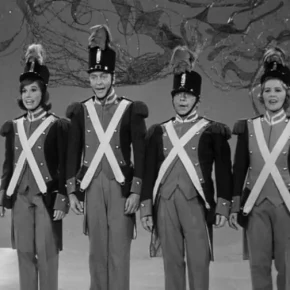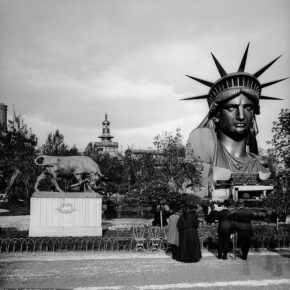Kudos to the six D.C. Council members who introduced the “Big Box Store Amendment of 2005” (a PDF of the amendment can be found here). In a nutshell, this bill will ban the construction or development of any “big box store” larger than 80,000 square feet. Ostensibly, this is aimed at keeping retail predators (read: Wal-Mart, Target, Home Depot, Lowe’s) out of the District, which is something I appreciate.
While there is a bit of convenience in having a one-stop retailer available (“I need some carrots, motor oil, polo shirts, 2×4 lumber and the latest Spïnal Tap CD, and I want it all in one stop”), these retailers often undercut the local, mom-and-pop stores that are the cornerstones of healthy neighborhoods. Especially damning is Wal-Mart, which not only stifles local retailers, but preaches an ultra-conservative, anti-worker, theocon gospel: workers aren’t allowed to unionize, pharmacists are barred from providing emergency contraception, and music sold at their locations is often censored or altered.
But back to the bill. This bill may also throw a wrench in the financing of a new stadium for the Nationals, as one of the possible stadium construction and finance plans involves the construction of a big box retailer (either a Wal-Mart, Sam’s Club, Costco, or the like) that will get naming rights for the ballpark as well as a location in southeast D.C. Frankly, the destruction of an area that is coming back to vibrancy on its own is not worth it, and I’m glad to see members of the Council taking this into account.















Sam
19 April 2005 — 14:05
I have a clarification question about this. What of the rumor (fact?) that Target is building in Columbia Heights. Would this impact that development and what do you think about that?
I, for one, have mixed feelings. Right now I buy TP or soap at CVS when I am in a pinch. Target is no worse and I would stay in DC to shop there instead of giving my sales tax dollars to Virginia.
At the same time, I think these beasts are ugly and undermine the local “feel” of an area.
Thoughts?
Grand Poobah
19 April 2005 — 15:02
From what I can tell (and I’ll call Kwame Brown to get clarification on it, because the bill isn’t overly clear), all existing projects, such as the under-construction Target in Columbia Heights and the already-present Home Depot on Rhode Island Avenue, will be grandfathered into an exemption from the new regulations. However, if either project decides to increase square footage, they’d fall under the new rules and regulations.
And I’m with you: I’d much rather my tax dollars stay in the District, and I’ll probably shop at Target for certain things. I already stop by the Target locations in Pentagon Row and Fairfax, if I happen to be in their respective areas. I’ve never been to the local Home Depot, but I’m not wholly averse to going there for certain home items. But I will still try and stay local, within reason: I still shop at the local Rite-Aid and CVS for certain things, but I’m also likely to stop at a local bodega or deli for the same things. Living on a budget also places certain constraints on spending, so there are times when a better price will rule the day – even though it’s fairly easy to bargain hunt within D.C., provided you keep on top of the adverts in the Sunday paper, clip coupons and buy in bulk.
There are cases where traditionally “big box” and national retailers have had to bend to the will of local regulations. For example, there are CVS and Rite-Aid stores that have Victorian and Colonial storefronts throughout the Mid-Atlantic and New England. Some stores scale back to fit in (e.g. the Safeway in Middleburg, VA, which is quite small yet an “organic” part of Main Street). And some of these retailers give quite a bit back to the local community without promoting any political agenda.
My fear is that, since the big box retailers have essentially reached saturation in all the surrounding communities, they see D.C. as the next target and want to quickly saturate the District’s retail landscape. That’s how Wal-Mart operates, and it explains their success, as well as the rapid decline of Main Street retailers across the country. Take into account the large population of lower-middle class people who will place price over loyalty, and it spells tough going for local retailers – especially those outside of northwest, where a more affluent populace will continue to support the smaller shops as their income is more plentiful and fluid. If big boxes set up shop in northeast or southwest, what little pockets of local retail still exist can be ruined.
However, I don’t want to see the small-scale flavor of D.C. be further hampered by the introduction of huge box retailers. After all, parts of the city have come back without the presence of a Wal-Mart, a Target, a Costco or a Lowe’s. Just twenty years ago, Dupont Circle was at a low point, with vacancies all over the place, and it has been reborn into a cultural focal point (though it could be argued that Dupont has been taken over by national retailers and isn’t as much of a local neighborhood, but I digress). The southeast waterfront is also coming back from years of decline, albeit slowly and with a lot of open-ended questions thanks to the baseball stadium project. 8th Street, SE, is a lovely retail and dining enclave that has come back from depression in the past ten years.
None of these rebirths required the construction of a behemoth box store. Yes, there are some national influences that are annoying (read: Starbucks), but the scale has largely been of the small-footprint, neighborhood-size location that makes D.C. so inviting. If I want big boxes en masse, I’ll head out to Seven Corners, the Rockville Pike or Tyson’s – all areas where you can’t easily get from point A to point B on foot, where there are no sidewalks, and where the only thing facing the roadway is either acres of paved parking or a faceless, windowless, cinderblock wall. Frankly, such places make me feel better about D.C., and more likely to spend my money locally. After all, in the end the cost savings are mitigated by high petrol prices.
The beauty of the D.C. Council bill is that it stipulates “sympathetic exterior design” for any large retail building. These can’t be cookie-cutter structures: they must have windows, balconies, overhangs, and all the other trappings of row house and old-time warehouse buildings. Parking areas must blend into the local landscape, with sightlines broken by foliage or earthen berms.
Another thing that I like about this bill is that it has support from both sides of the Anacostia, as well as from both sides of the stadium financing issue. Kwame Brown and Marion Barry both live in areas in need of economic growth, yet they see the long-term drawbacks of throwing open the doors to megastores. And Jack Evans – perhaps the biggest baseball booster in D.C. – is a co-sponsor of this bill, as well. He sees the benefits of keeping things small-scale.
(And frankly, where in Ward 2 could you place a large box store without decimating a neighborhood? Put it in Shaw and you’d have another riot on your hands.)
I guess I’m just a sucker for small-scale city living. If anything, Kunstler’s The Georgraphy Of Nowhere and Home From Nowhere turned me onto this concept of “organic” urban development and the vibrant, healthy, diverse society it creates. While I love New York City and its scale, I’m a sucker for seeing the sky and trees, where natural topography provides the most striking features on the horizon.